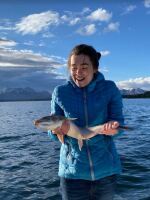Last month, three hikers travelled 50 miles along the Pebble Mine’s proposed transportation corridor, from Amakdedori beach on the west side of Cook Inlet to Iliamna Lake.
Salmon State Bristol Bay Campaign Coordinator Rachel James was one of the hikers. James said that she wanted to better understand how the region could be affected by a mine.
“What kind of impact would that have? What’s the landscape like now? What kind of animals live there? What’s the vegetation like? How many of these streams have salmon in them? Really just walk throughout the proposed industrial port site and the proposed road corridor to the village of Kokhanok to see what’s out there,” she said.
The four-day hike wasn’t easy. James was accompanied by writer Erin McKittrick and visual storyteller Jayme Dittmar, and she says that that area is conducive to rough weather.
“Amakdedori beach on the west side of Cook Inlet is incredibly exposed,” James said. “You have winds funneling up from the Gulf of Alaska up Cook Inlet. And those winds and big low pressure systems clash with the interior weather that comes in from Iliamna lake. That area that’s the low point in the Aleutian range is called Kamishak Gap, it’s just full of really violent, rough weather. So, we did encounter very challenging weather conditions; up to 50-mile-an-hour winds, sideways rain.”
Salmon State is an organization that opposes Pebble Mine. James said the purpose of the hike was to raise public awareness.
“I think it’s important for Alaskans to know that Pebble has proposed a permit in which they will put a huge industrial complex and road across waters that drain into Cook Inlet as well as Lake Iliamna,” James said.
Looking ahead, James is considering another hike around Bristol Bay’s headwaters.
Contact the author at isabelle@kdlg.org or 907-842-5281.



